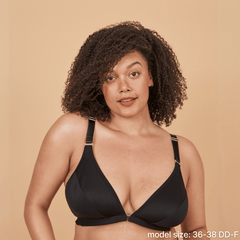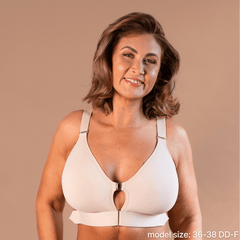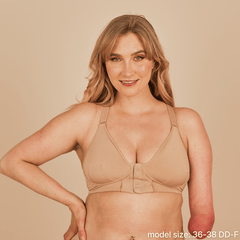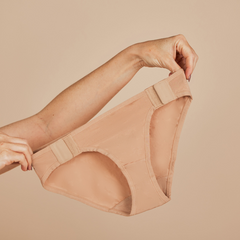
In the 21st Century, bras are an everyday staple item to which many women don’t give a second thought. However, bras are actually the product of thoughtful engineering and methodical design.
Each part of the bras has changed over time to balance and counter-balance each other to best support the wearer the way they’d like. Most lingerie brands take many months to design, prototype, fit, and modify a new bra style before taking it to the mass market—sometimes taking dozens of rounds of modification for one bra style.
As any bra-wearer knows, one size does not fit all.
Understanding which bra styles, sizes, and shapes fit you best can feel like a life-long challenge. A trip to the lingerie section of a store can bring feelings of dread, impatience, or expectations of a long changing room trip to try on many styles. Particularly for people with upper mobility challenges, finding the right fit may not only be inconvenient, but also painful or triggering.
Understanding the architecture of bras might help you narrow down which styles to consider, and a key “support beam” is the actual bra strap. Have you considered how the width might play a key role in how comfortable, supportive, and adaptive a bra is?
Let’s unpack the strap.
To understand the role a strap can play in your best fit, it’s helpful to understand the role of a bra with no straps or thin straps.
Of course, strapless bras are a go-to option for people who like to wear strapless tops and dresses. These strapless bras typically work best for a smaller bust, since with a heaver bust the wearer may need an overly tight band to stay up and supportive. A negative to strapless bras is the inherent risk of falling down, especially if it fits improperly.
Thin straps are the dominant style advertised in mainstream commercials, and are easier to hide under thin-strapped camisoles and tops. A pro of thin straps is that they can be more versatile, especially for those who want a convertible/multi-style bra.
On the other hand, those with a large bust will find that thin straps lack support and can leave red marks on the skin. Thin straps may be less comfortable over time, and are more likely to stretch out. For someone with upper mobility limitations, thin straps can mean tricky fine motor function and more dramatic movements to put on properly.
When most bra-wearers think about the downsides of their straps, an immediate image called to mind might be the painful red marks left after a long day.
What causes red marks?
Have you ever taken off your bra only to be left with unpleasant red dips on your shoulders after a long day? If that's the case, you're not alone.
When your straps are exerting more effort than they should, red markings appear. Contrary to common perception, your bra's straps should only provide around 20% of overall support. Eighty percent of the lifting is done by your bra band. If your bra band is too loose, it won't be able to provide you the support you need, putting too much strain on your straps.
Red markings indicate that you're wearing the incorrect band size or that your band has stretched. If you can't tighten your band any more, it's time to get a new bra. Finding a bra that fits properly and is suitable to your specific shape and size is the key to reducing red blemishes.

Is it normal to have red marks?
Yes, they can be normal to some extent—we are human, after all. Even when the fit is excellent, the bra straps rub against your skin, which might cause some redness.
Whatever material the strap is composed of, it will almost certainly leave an imprint, especially for people with large breasts. Normal red indents should fade in a few minutes and are not painful. If your bra straps lead to marks that last an hour or longer, produce deep indents, or lead to bruising, it is absolutely time to double-check your size and consider another style.
If you have large breasts, try to switch bras every day over every other day so that you don't put pressure on the same areas. Give your body a break by switching bras with different types of straps, such a t-shirt bra one day and a racerback the next.
This bring us to our central question: what are the benefits and downsides of wide straps?
Pro: Wide straps can help with red marks.
Wide straps help to distribute the weight of breasts across a larger surface area. Often, wide straps also allow for extra padding, which gives the shoulders a bit of a cushion. They are also less prone to fall off the shoulders.
Wide straps are particularly helpful for a full bust, since people with heavier breasts are more likely to get red indents with thin straps even when the bra fits perfectly. Remember, even a perfect-fitting bra with wide straps may still leave light red marks, but these are much more likely to go away after a few minutes and should not be painful.
Pro: Wide straps come in more materials.
While thin straps tend to be made of typical elastic or synthetic stretchy material, wide straps tend to be less stretchy in order to support you. Also, due to their larger surface area, wide straps can be made of a larger variety of materials and even include some padding within the strap to help with red marks and minimize slippage.
Con: Wide straps may be more noticeable under certain styles of clothing.
Of course, by necessity wide straps take up more space on the shoulders, meaning they cannot be hidden with a spaghetti-strap or camisole shirt. If the wearer prefers not to show bra straps, it is recommended to wear a thick-strap tank top, t-shirt, or sleeved top so as to cover the bra straps.
Pro: Wide straps tend to be more wide-set from the neckline.
Wider straps tend to set further apart, and allow for a wider neckline. This can be particularly helpful for people with upper mobility limitations, since there is more space to get in and out of the bra, plus wide-neckline clothes can be easier to slip on/off with less movement.
Con: Wide straps may be less customizable.
Some wide straps are adjustable so that the fastener moves along the entire width of the strap. Full-support bras with wide straps may be fixed for the front half, and only have the fastener adjustable for the back half of the bra. This means there may be a tradeoff between customizing the shoulder fit and having full support; remember that a properly-fitting bra is the best defense against discomfort.
Pro: Wide straps are more likely to lay flat against the skin.
The width and slight weight to the wide strap means—with a properly fitting bra—the strap is more likely to lay flat against the skin than thin straps, which might tug upright creating a gap. This is a particular benefit when wearing t-shirts or a thin top, since a ‘strap gap’ is more noticeable through thin fabric.
Final Thoughts
There are advantages and drawbacks to any bra strap style, but at Springrose we prioritize those who have upper mobility restrictions who are just as deserving as adaptive, attractive, and comfortable bras.
After talking to physical and occupational therapists, as well as dozens of women in a large range of sizes, the answer is clear: wide straps work.
This is why the Springrose bra features a 3/4-inch strap—balancing between comfort, support, style, and adaptive



